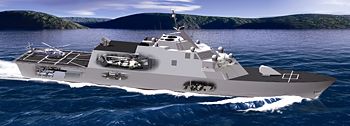Littoral Combat Ship: Difference between revisions
imported>Howard C. Berkowitz No edit summary |
imported>Howard C. Berkowitz No edit summary |
||
| Line 2: | Line 2: | ||
{{TOC-right}} | {{TOC-right}} | ||
A '''Littoral Combat Ship''' is a [[United States Navy]] warship intended to reverse the Cold War trend towards large, expensive warships optimized for open-ocean operations, | A '''Littoral Combat Ship''' is a [[United States Navy]] warship intended to reverse the Cold War trend towards large, expensive warships optimized for open-ocean operations. As opposed to [[fast attack craft]], it is capable of transoceanic voyages to reach its operational area, but, once there, is optimized for [[littoral (military)]] coastal waters. In comparison to LCS, which are ships of approximately 3,000 ton displacement with a crew of 40, the extremely competent, multirole [[Burke-class]] destroyers are in excess of 9,000 tons with a crew of 300-400 sailorss. | ||
[[Image:General Dynamics LCS Concept.jpg|thumb|400px|left|Modular concept illustrated with General Dynamics design]] | [[Image:General Dynamics LCS Concept.jpg|thumb|400px|left|Modular concept illustrated with General Dynamics design]] | ||
There are two prototype classes being built by different design teams, but they share the ability to be quickly (1-4 days) reconfigured for with ''mission modules'' for [[mine (naval)|mine warfare (MIW)]], [[anti-submarine warfare]] (ASW) and [[anti-surface warfare]] (ASW). While small, they will always have the capability to operate [[helicopter]]s and [[unmanned aerial vehicle]]s (UAV). | There are two prototype classes being built by different design teams, but they share the ability to be quickly (1-4 days) reconfigured for with ''mission modules'' for [[mine (naval)|mine warfare (MIW)]], [[anti-submarine warfare]] (ASW) and [[anti-surface warfare]] (ASW). While small, they will always have the capability to operate [[helicopter]]s and [[unmanned aerial vehicle]]s (UAV). | ||
Revision as of 22:10, 9 April 2009
A Littoral Combat Ship is a United States Navy warship intended to reverse the Cold War trend towards large, expensive warships optimized for open-ocean operations. As opposed to fast attack craft, it is capable of transoceanic voyages to reach its operational area, but, once there, is optimized for littoral (military) coastal waters. In comparison to LCS, which are ships of approximately 3,000 ton displacement with a crew of 40, the extremely competent, multirole Burke-class destroyers are in excess of 9,000 tons with a crew of 300-400 sailorss.
There are two prototype classes being built by different design teams, but they share the ability to be quickly (1-4 days) reconfigured for with mission modules for mine warfare (MIW), anti-submarine warfare (ASW) and anti-surface warfare (ASW). While small, they will always have the capability to operate helicopters and unmanned aerial vehicles (UAV).
Note that there is a launching and retrieval ramp on the stern; this will allow all configurations to launch special operations boats and remotely piloted vessels. There are hangars for two MH-60 helicopters, but the landing area is sufficient for the large CH-53 Sea Stallion heavy-lift or MH-53 PAVE LOW special operations helicopter. They also are using the MQ-8 helicopter UAV, three of which will fit in the hangar space of one MH-60.
In all configurations, the vessels have a light 57mm autocannon that can still provide close-in naval gunfire support as well as engaging surface and air targets. They also carry lighter autocannon and RIM-116 Rolling Airframe Missiles for self-defense against aircraft and cruise missiles; the ships are also designed to mesh into military electronic networks.
Designs
Both contractors were to build prototypes. Lockheed Martin is building two ships, USS Freedom and USS Courage. The other two, by General Dynamics, are the USS Independence and USS Liberty. While the performance of the two is intended to be in the same range, the hull forms are quite different. Lockheed Martin's is a single hull that "semi-planes", or moves partially out of the water at high speed. The General Dynamics approach is a multi-hulled trimaran.
Deployment
LCS 1 was commissioned in November 2008, following LCS 2's commissioning in October. These are Flight 0 vessels. In January 2007, the USN stopped work on LCS 3 due to cost concerns, and terminated the contract in April. LCS 4 was also cancelled in October 2007.
Secretary of Defense Robert Gates, in presenting the proposed Defense Department budget on April 6, 2009, said "We will increase the buy of Littoral Combat Ships (LCS) – a key capability for presence, stability, and counterinsurgency operations in coastal regions – from two to three ships in FY 2010. Our goal is to eventually acquire 55 of these ships."
To increase availability, each ship will have two crews, "Blue" and "Gold", which will take turns manning the vessel at sea. This approach has been used successfully with submarines.

